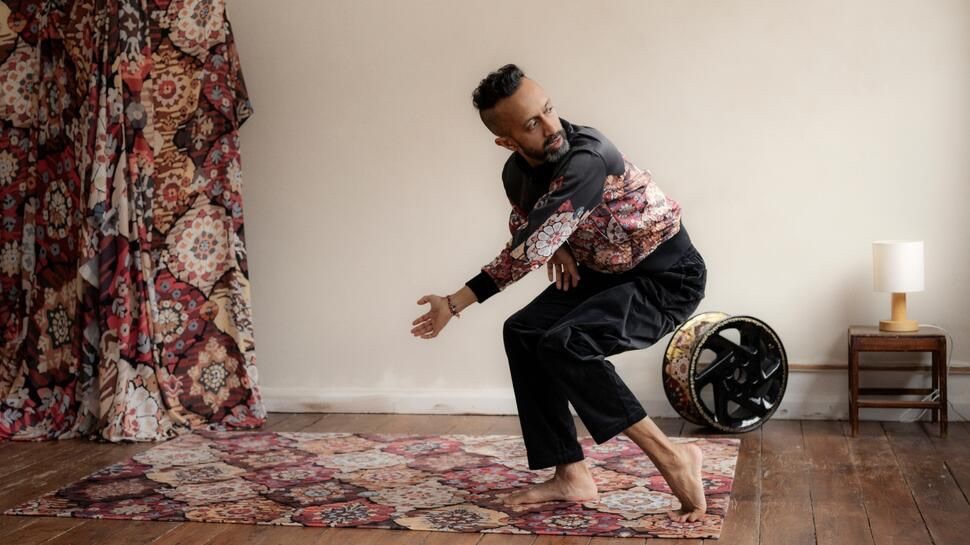Words by Qiao Lin Tan.
In The Pit of the Barbican Centre, a spotlight illuminates a circular carpet of rich red, yellow and orange flowers. To the side, a throw cushion and the steel wheel of a car’s tyre sport intricate blossoms as well. At the lights dim to signal the start of the work, a voice recording of a woman speaking interchangeably in Gujarati and a British-accented English plays, describing the carpet that she painstakingly chose and bought for her home all those years ago.
Hetain Patel, the creator and performer of Mathroo Basha (which means mother tongue in Gujarati), steps onstage and greets the audience. Casually, he explains that this work is made from the voice recordings of interviews he conducted with members of his family. The carpet on the floor was made by him in his art studio, a replica of the one in his grandmother’s house. He will be responding physically to the interview recordings in this work.
Positioning himself at the head of the carpet, the informal atmosphere abruptly shifts as he steps one foot into the circle – carefully, purposefully, meditatively. The voices of women lament the loss of traditions and rituals, the erosion of language, the enduring food tradition. In the background, over and over, Patel explores the movement of only his legs and feet. Then only his arms and hands, over and over. Patel was beckoning that I follow along into his world of meditation and introspect – the lights dimmed, sonorous music started, and his gaze turned inwards. But, unprimed for the atmosphere as I was, I found myself lagging behind. The whiplash between the informal, conversational introduction by Patel and then suddenly being dropped unceremoniously in the middle of his own deep internal physical exploration meant that I found myself on vastly different wavelengths from him.
I waited in anticipation for the image to shift, as movement is wont to do when it is repeated and repeated over and over. However, it never revealed itself to me and the body onstage remained opaque and impenetrable. The movements performed one after another never touched, unrelated movements strung together with no reference to each other and no distinct thread that tied them together. As I hoped for a new image to emerge out of the monotony onstage, I found my focus drifting towards the recorded text instead.
Featuring the voices of an aunt, a sister and a nephew, the interviews revealed the state of the different relationships each had to the Gujarati heritage that was brought over by the first of the Patels to move to England. The nephew suggests to Uncle Hetain ways that they could both learn more Gujarati words because they didn’t know many. The sister ruminates over how although Gujarati was the first language she learnt, English is the language of her internal dialogue. Auntie easily switches between English and Gujarati as she spoke, sentiments that only speakers of both languages would be able to fully understand. The text filled the space, the time, and my attention – fitting for a work titled mother tongue.
For non-Gujarati speakers like myself, the unknown language sprinkled throughout the text served to emphasise a sense of alienation, of always being one step removed from the action. In a similar way, perhaps, to how one who thinks in English might feel when speaking Gujarati. Or a child who speaks only English, surrounded by a Gujarati family. Patel leans into this and creates a further distancing effect with a passage spoken by his mother in English and Gujarati. He first sings this passage repeatedly, the tempo of his singing serving to create pauses in the natural cadence of the original sentences that seem to move it further away from its meaning. The original interview recording then plays and Patel layers his own voice over his mother’s – both of them repeating her words again and again, taking us further and further away from what any of the original meaning might have been. By the end, even the English words sound alien.
How does one go about normally with an unfamiliar, alien tongue, when it is essential for speaking? I suppose Patel’s solution is to adapt and change. After a monologue in which he describes his desire for freedom, the carpet turns ingeniously into a skirt that Patel dons and spins round and round with his arms out, hurtling through the space – the first time in the entire work that he ventures out of that two square metres of carpet. He spends a moment lavishing in his body and the way it throws shadows on the wall. These delicious moments of catharsis are short-lived, however, as Patel returns back to the centre and the lights fade to black, leaving me craving more of that freedom and reckless abandon.
The investment in the research and creative process in Mathroo Basha is evident – from the intricate designs of the set and costume, to the painstaking selection and curation of the voice over text and soundscape. However, this same intentionality does not seem to have translated into the body’s movement, and the contrast is stark when these elements all sat side by side onstage. Still, I am thankful for the intimacy and vulnerability offered so generously in this work, and as a member of an overseas diaspora as well, the work’s messages of heritage, history, erosion and alienation resonate strongly with me.
